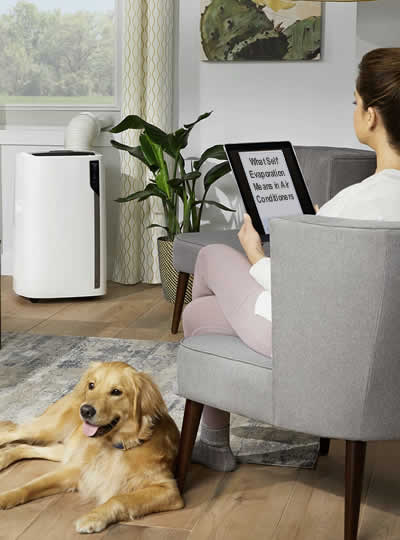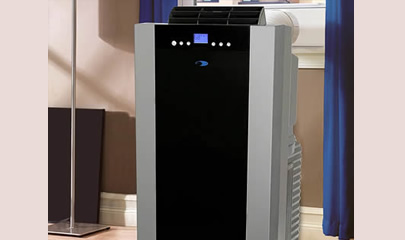What Self Evaporation in Air Conditioners Means
With some portable or window air conditioners, there is a reference to a self evaporation capability. What is meant by a self evaporating air conditioner and what are the benefits of owning this type of cooling device?
Let's take a look at this type of AC unit and see what's going on under the hood and how it will benefit the owner.
Atmospheric Moisture Removal
 As well as being able to blow cool air into a room, an air conditioner also draws the moisture out of the air in the room and into the air conditioning unit.
As well as being able to blow cool air into a room, an air conditioner also draws the moisture out of the air in the room and into the air conditioning unit.
Unsurprisingly, this moisture has to go someplace.
Well, window and portable self-evaporating air conditioners come with a patented additional feature giving them the ability to get rid of this excess moisture for you.
Also unsurprisingly, these devices are growing in popularity!
Air Conditioners Deal with Humidity
All homes and other occupied buildings naturally contain a level of humidity in the air.
Humidity is just the term for moisture held in the air in the invisible form of water vapor. This extra water vapor is present in the air indoors because of normal human functions such as simply breathing or perspiring as well as normal actions like cooking or bathing.
The more activity there is to cause water to evaporate into the air, the more the interior relative humidity level increases.
An air conditioner naturally removes this airborne moisture while it works to cool the air. This is the reason why most window air conditioners are installed sloping slightly down towards the outside.
Airborne moisture (humidity) is condensed back into liquid form inside the AC unit.
The sloping aspect allows it to drain to the outside where it is collected inside a container. Often this is just a bucket that needs to be emptied regularly when the air conditioner is in operation.
Self-Evaporating Air Conditioners
There are a number of self-evaporative air conditioner models on the market that effectively eliminate the need for water tank emptying in most cases.
Recommended: Whynter ARC-14S
 CLICK READ MY REVIEW
CLICK READ MY REVIEW
Manually emptying a container of collected water outside or a portable AC unit's water collection tray is a chore that can actually be done away with by changing to an air conditioner featuring self-evaporating technology.
This type of window AC unit is also referred to as a no-drip unit because there is no water to drip from the outward-facing side of the unit.
Interestingly, it is now possible to obtain WiFi ready, smart portable air conditioners and smart window AC units that allow you to control them via a phone app for extra convenience.
Recommended: LG LP1021BSSM
 CLICK READ MY REVIEW
CLICK READ MY REVIEW
How Self Evaporating AC Units Work
A self-evaporating AC unit recycles around half of the water it condenses and reuses it to assist in cooling the inner cooling coils. This allows the unit to run much more efficiently and economically, saving you money on electricity bills.
After re-use, the recycled water is then re-evaporated and dispersed into the outside air with the hot air that is also created by the refrigeration process. It is possible to feel the heat exiting the back of a portable or free-standing air conditioner.
While window AC units manage the whole process internally and exhaust the hot, moist air out the back of the unit into the air outside, portable AC units do this by dispersing the heat and moisture through the vent pipe that is connected to a convenient nearby window.
A self-evaporating AC unit simply eliminates any unnecessary water from collecting in a tray inside the unit or dripping into an outside container.
Self-Evaporating AC Maintenance
There are a few maintenance jobs that still need to be done with a self-evaporative air conditioner. These are mainly to ensure efficient operation and extending the unit's lifespan.
It is possible that the room that the air conditioner is installed in has a high level of humidity. In this case, the water condensing inside the unit can accumulate more quickly than the unit can effectively recycle and exhaust to the outside air.
When indoor atmospheric conditions are like this, it is necessary to manually empty the excess water that will collect in the dehumidification collection tank located at or near the base of the self-evaporating unit. If this sounds a little confusing, it actually isn't.
All air conditioners naturally dehumidify the air as they cool. However, many AC units also have a dedicated dehumidification cycle, which will remove much more moisture from the air as is done during the normal cooling cycle. This extra moisture is collected in its own tank.
It is best to read the owner's manual in order to learn when manual emptying becomes necessary and how to find, remove and replace the tank on your specific AC model.
Improving the Efficiency of the AC Unit
It is possible to improve the operating efficiency of the AC unit by taking certain actions.
First is to take steps to lower the indoor humidity level yourself. This will prevent the self-evaporating AC unit from becoming overloaded with condensed water that you have to empty.
By improving ventilation in bathrooms and kitchen to remove excess moisture created when cooking or bathing, you will reduce the humidity level of the air in the home. This simple task can help save money on the operation of the air conditioning unit by making it work more efficiently.
Variations in the atmospheric humidity determine the rate at which the AC unit's water container will fills up.
By investing in a hygrometer (to measure humidity) you will be able to see if the air moisture level has become excessive. It is also possible to use a dehumidifier in rooms where humidity levels are too high to reduce the moisture level and provide a better atmosphere for the air conditioner to work in.
Conclusion
Owning a self evaporating air conditioner can greatly benefit the owner by reducing or even eliminating the need to empty a water catchment vessel periodically.
This type of cooler is also more efficient and economical to run, making it the next step up from traditional cooling devices.
That concludes the explanation of what self-evaporation in air conditioners means and how it benefits the owner.
Last Updated: May 14, 2025
![]()

